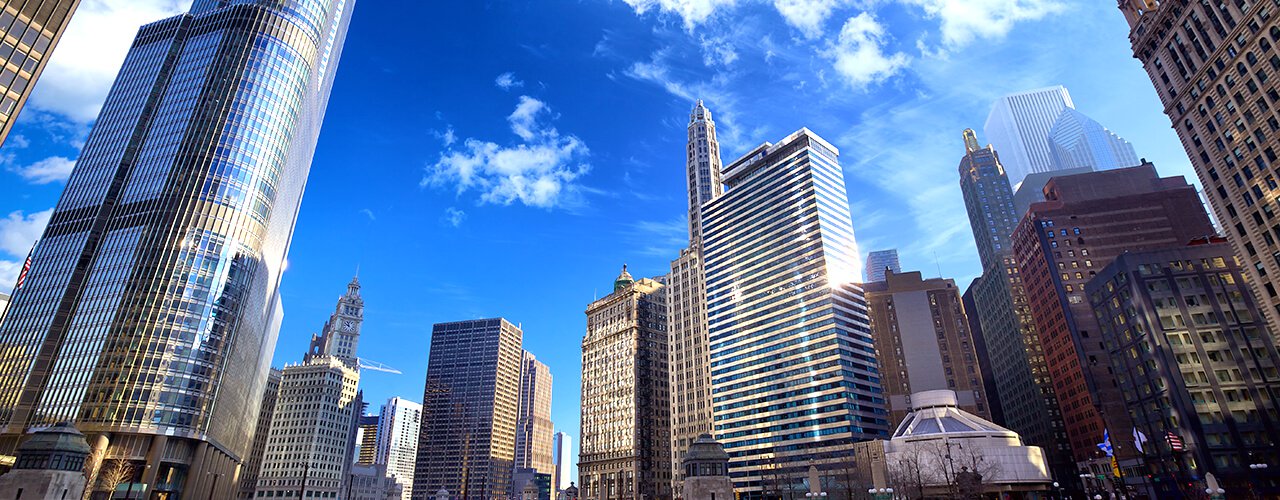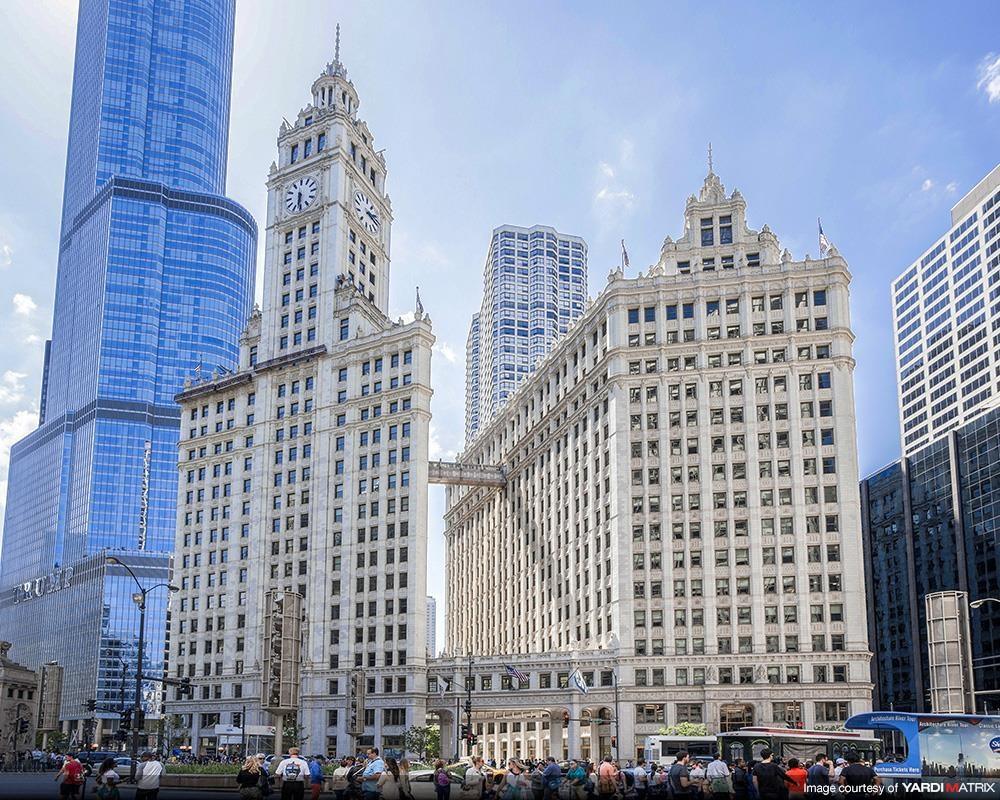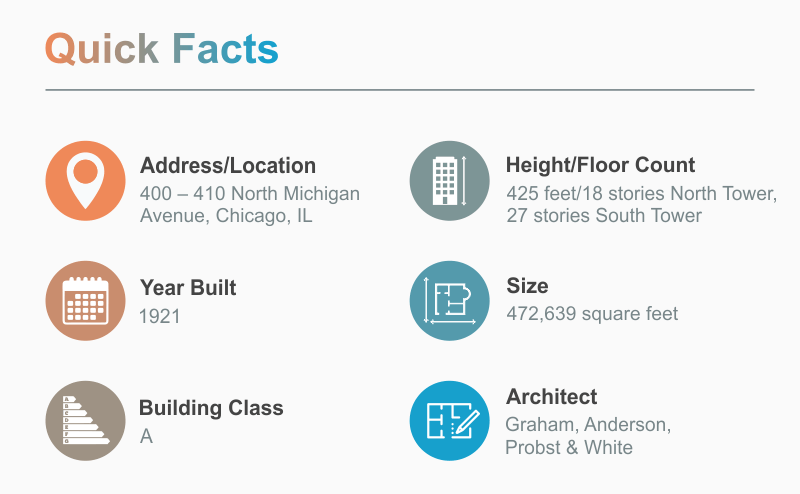Known as the “Gateway to the Magnificent Mile” in Chicago, the twin towers of the landmark Wrigley Building stand where Michigan Avenue crosses north over the Chicago River. The building was constructed by chewing gum magnate William Wrigley Jr. and served as the company’s headquarters until 2012.
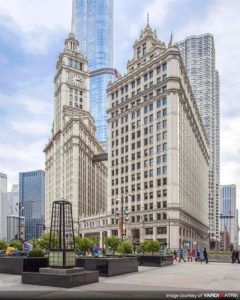 Located in the Near North Side Chicago office submarket, the Wrigley Building was the first of several iconic Chicago office buildings built during the construction boom of the 1920s. Other famous neighbors of the Wrigley Building along the Magnificent Mile include the London Guarantee Building in 1923, the Tribune Tower in 1925, and 333 North Michigan Avenue in 1928.
Located in the Near North Side Chicago office submarket, the Wrigley Building was the first of several iconic Chicago office buildings built during the construction boom of the 1920s. Other famous neighbors of the Wrigley Building along the Magnificent Mile include the London Guarantee Building in 1923, the Tribune Tower in 1925, and 333 North Michigan Avenue in 1928.
The Wrigley Building consists of two towers connected by three pedestrian walkways. The 27-story South Tower with over 161,000 rentable square feet was completed in April of 1921. Three years later the 18-story North Tower was finished, adding over 311,000 square feet of rentable space to the Central Chicago office market.
Two walkways originally connected the two towers, one at ground level and a second walkway at the third floor. In 1931 the third 14th-story walkway was added to connect offices of a bank as required by a City of Chicago statute.
The four faces of the clock on the South Tower are each about 20 feet in diameter. The hour hands are over 6 feet in length, and the minute hands are over 9 feet long. The 250,000 terra-cotta tiles on the Wrigley Building are six different shades of white – from blue-white at the base to a creamy-white at the very top – making the property look brighter as it soars high above Michigan Avenue.
Unlike the Chrysler Building in Midtown Manhattan and the Transamerica Pyramid in the San Francisco Financial District that were originally criticized for their design, Chicagoland residents immediately fell in love with their Wrigley Building. When the building first opened there was an observation deck on the 26th floor of the South Tower and for only five cents visitors gained access to the observatory and received a piece of Wrigley gum. The Wrigley Building has been featured in movies including Backdraft, The Fugitive, and the 1957 sci-fi film Beginning of the End where giant grasshoppers scaled the building.
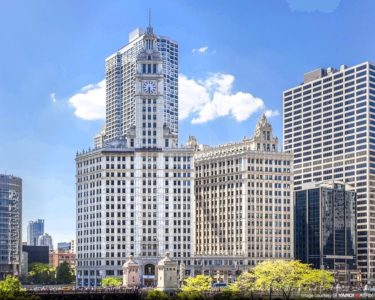 Although the Wrigley Building was constructed almost 100 years ago, nearly $70 million in renovations completed in 2013 have kept the building’s office space Class A with an Energy Star and a LEED certified gold rating. The building boasts two new lobbies, new elevators, and new HVAC, plumbing, and electrical systems.
Although the Wrigley Building was constructed almost 100 years ago, nearly $70 million in renovations completed in 2013 have kept the building’s office space Class A with an Energy Star and a LEED certified gold rating. The building boasts two new lobbies, new elevators, and new HVAC, plumbing, and electrical systems.
Amenities in the Wrigley Building are similar to those found in prestigious coworking locations in San Francisco, Manhattan, and Chicago. The property has a state-of-the-art conference facility, tenant lounge and fitness center, and an expansive three-level plaza with over 52,000 square feet of restaurant and retail space.
Since 2012 the Wrigley Building has received numerous awards and recognition including:
- City of Chicago Landmark 2012
- AIA Chicago Honor Award for Distinguished Building 2014
- NAIOP Chicago Award for Excellence, Office Redevelopment of the Year 2014
- City of Chicago Office of the Mayor Landmark Award for Preservation Excellence, Exterior Renovation 2014
- International BOMA TOBY Award: The Outstanding Historical Building of the Year 2017
Although the Wrigley Company no longer occupies the building, the name can never be changed due to deed restrictions made when the building was first sold, ensuring that this iconic Chicago office building will boast the Wrigley name for many generations to come.
Images courtesy of Yardi Matrix

